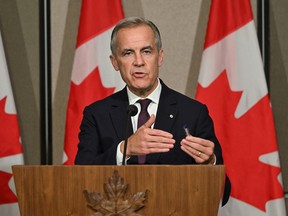
Article content
Canada’s federal deficit could go as high as an unprecedented $100 billion in this fiscal year, leading at least one economist to warn that the country shouldn’t take its gold-plated AAA credit rating for granted.
THIS CONTENT IS RESERVED FOR SUBSCRIBERS ONLY
Subscribe now to read the latest news in your city and across Canada.
- Exclusive articles from Barbara Shecter, Joe O'Connor, Gabriel Friedman, and others.
- Daily content from Financial Times, the world's leading global business publication.
- Unlimited online access to read articles from Financial Post, National Post and 15 news sites across Canada with one account.
- National Post ePaper, an electronic replica of the print edition to view on any device, share and comment on.
- Daily puzzles, including the New York Times Crossword.
SUBSCRIBE TO UNLOCK MORE ARTICLES
Subscribe now to read the latest news in your city and across Canada.
- Exclusive articles from Barbara Shecter, Joe O'Connor, Gabriel Friedman and others.
- Daily content from Financial Times, the world's leading global business publication.
- Unlimited online access to read articles from Financial Post, National Post and 15 news sites across Canada with one account.
- National Post ePaper, an electronic replica of the print edition to view on any device, share and comment on.
- Daily puzzles, including the New York Times Crossword.
REGISTER / SIGN IN TO UNLOCK MORE ARTICLES
Create an account or sign in to continue with your reading experience.
- Access articles from across Canada with one account.
- Share your thoughts and join the conversation in the comments.
- Enjoy additional articles per month.
- Get email updates from your favourite authors.
THIS ARTICLE IS FREE TO READ REGISTER TO UNLOCK.
Create an account or sign in to continue with your reading experience.
- Access articles from across Canada with one account
- Share your thoughts and join the conversation in the comments
- Enjoy additional articles per month
- Get email updates from your favourite authors
Sign In or Create an Account
or
Article content
“While a debt downgrade isn’t imminent, Canada’s AAA status shouldn’t be taken for granted,” Randall Bartlett, deputy chief economist at Desjardins Group, said.
Article content
Article content
Article content
Based on announced increased spending and tax cuts by the federal government, Desjardins, in a report, estimated the deficit could hit $70 billion for the fiscal year 2024-2025, but could also climb as high as $100 billion.
Article content
By signing up you consent to receive the above newsletter from Postmedia Network Inc.
Article content
Previously, Canada’s deficit was projected to come in at between $48.3 billion and $43.2 billion.
Article content
Among the major spending increases pressing on Canada’s finances is a pledge by Prime Minister Mark Carney to increase defence spending to two per cent of gross domestic product (GDP), with a potential price tag of $9.3 billion in this fiscal year, as well as increased money for housing and a tax cut of one per cent for the lowest tax bracket. The government is also expected to take in less revenue due to tariffs.
Article content
“All of this is expected to add up to bigger deficits and higher debt and ultimately risks putting federal finances on an unsustainable path,” Bartlett said.
Article content
The country’s debt-to-GDP ratio is also expected to increase rather than slow as previously pledged in the fiscal economic statement released last December during the final days of Justin Trudeau’s tenure.
Article content
Article content
The debt-to-GDP ratio in the last fiscal year was 42.1 per cent, and it was projected to drop to 41.9 per cent in this fiscal year and to 38.6 per cent by 2029-2030.
Article content
Article content
However, that ratio is now expected to rise to 43 per cent “over the medium term,” according to a September report by the Parliamentary Budget Officer (PBO).
Article content
“Compared to our March outlook, the federal debt-to-GDP ratio is 4.5 percentage points higher in 2029-30 and is no longer projected to be on a declining path over the medium term,” the report said.
Article content
Bartlett said Canada’s apparent deteriorating debt-to-GDP ratio represents a big change from a year ago and is one less positive metric in the country’s arsenal.
Article content
“My sense is that, given everything that has been changing domestically and internationally, while Canada’s credit rating is probably not at an imminent risk of being downgraded, we’re not on the kind of positive trajectory we were on even just a year ago, when the federal government was forecasting a falling debt-to-GDP ratio,” he said. “That would have done more to secure the outlook for the credit rating than the path that we’re on right now.”

.jpg) 2 hours ago
2
2 hours ago
2
 English (US)
English (US)